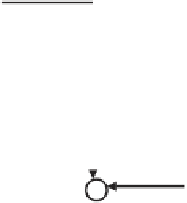Global Positioning System Reference
In-Depth Information
example, allowance of 90º of phase error (one quarter cycle) translates to roughly 5
cm of navigation error. Analysis performed in Section 9.2.4.6 indicates that this
translates to a very tight GPS/INS velocity accuracy requirement. This requirement
can be attained, but only with very careful estimation and control of certain IMU
error sources, along with IMU data extrapolation to achieve the needed update rate
for phase lock. In addition, special care is necessary in the installation of the GPS
antenna on the vehicle, relative to the IMU, to avoid contamination by flexible body
motion between the two. In fact, for best operation of carrier-phase aiding, consid-
eration should be given to minimizing the physical separation between the INS and
the GPS antenna in the host vehicle. Notwithstanding the difficulty of aiding phase
lock within the GPS receiver, aiding frequency lock is relatively easy to do. Further
discussion of this alternative appears in Section 9.2.4.6.
Since aiding the code loop is commonly done, let us explain its nature at a con-
ceptual level with reference to Figure 9.11. Note that the code loop nonlinearity is
neglected in this simplified model (the detector is represented by a gain of unity), and
the NCO within the receiver is represented as an integrator. Also note that the code
loop filter is represented simply as a gain,
K
c
, and a continuous time model is shown.
First, to explain the action of an aided code loop with reference to Figure 9.11, the
range delay,
ρ
, minus the loop's estimate,
ρ
est
, measures the range delay tracking
error
, which is computed perfectly by the detector with an additive noise error,
n
.
The loop bandwidth is proportional to the code loop gain
K
c
. The INS velocity is
subtracted from the satellite's velocity (in a common coordinate frame) and then
projected along the LOS to the satellite that is tracked by the loop to construct
d
δρ
/
dt
INS
. The INS aiding signal is added to the output from the code loop filter to
drive the NCO. As mentioned previously, oscillator imperfections lead to a fre-
quency error,
ρ
δ
f
, which also drives the NCO, in addition to an additive clock phase
error
. The very simple form for this model makes certain observations intuitive.
Lowering the bandwidth (reducing
K
c
) reduces the effect of noise,
n
, or interference
on the loop, and places more weight on the INS aiding. As a limiting case, setting
K
c
to zero drives the range delay estimate entirely with inertial aiding. Even in the case
of perfect INS information, this is unwise, since the frequency error of the local
oscillator will integrate to a range delay error, which cannot be removed by the
zero-bandwidth loop. This range delay error will grow without any corrective
δϕ
n
+
ρ
δρ
+
1
K
c
−
ρ
est
Code loop
filter
Code loop
detector model
δϕ
δ
f
+
+
INS
d /dt
+
ρ
+
+
+
1/s
NCO
Figure 9.11
Simplified (linear) model for aided code loop.

















Search WWH ::

Custom Search